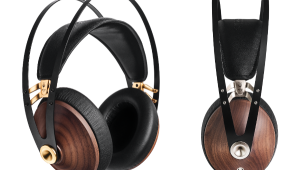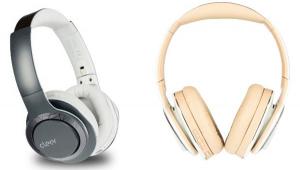Review: Creative HN-900 Headphone

Thanks to Bose’s overwhelming success in the category, most of us now think of noise-cancelling headphones as products that cost about $300. I’m sure every other headphone company would like to thank Bose for that, even if none of them ever will. But there’s really no reason that a noise-cancelling headphone has to cost so much. The basic noise-cancelling circuit is pretty simple: just a couple of cheap, tiny microphones feeding a simple amplification stage with some filter circuits thrown in.
In fact, noise-cancelling ’phones can cost much less: $99 in the case of the Creative HN-900.
There’s nothing about the HN-900’s appearance to suggest it’s a price-slashed model. It looks quite a bit like the Bose QC15 — no accident, I’m sure. There’s a AAA battery inside the right earpiece, and a NC on/off switch with LED indicator on the left earpiece. The HN-900 still works when NC is switched off, so you’re not stuck with silence if your battery runs down. The detachable cord includes an inline mic for use with your iPhone.
So the question is: At one-third the price of those “name brand” noise-cancelling headphones, does the HN-900 give you just one-third the performance? Or can it do better?
Ready for Travel?
The HN-900 isn’t as comfortable as the QC15, but not many headphones are. That said, it’s way more comfortable than average, especially for the price. I found the ear cups just barely big enough for my rather large pinnae. While the grip was a little tight for my head, I found it comfortable enough for a 90-minute ride on L.A. public transit. My fellow Tech^2 blogger Geoff Morrison agreed.
The noise-cancelling feature was moderately effective — not the best I’ve encountered, but it did cut down on some of the low-frequency rumble from the Orange Line bus. I got a similar result when I played a recording of jet airplane cabin noise through my home theater system. It certainly offers enough low-frequency noise reduction to make a flight more enjoyable.
The sound in passive mode, without noise cancelling, is radically different than in active mode. It becomes very bassy, with a strong resonance in the upper bass, which subjectively makes the treble sound dull. On “Land of 1,000 Dances,” from Steve Cropper’s With a Little Help From My Friends — a sadly obscure Memphis soul gem from the house guitarist at Stax Records — it sounded to me like the late Donald “Duck” Dunn’s bass amp was half-filled with mud. So you can use it when the battery runs down, but you probably won’t like the sound much. Better than silence, though.
Getting Active
Putting the passive mode past us, Geoff and I settled on the active mode for the rest of our listening.
I was thrilled and a little shocked to hear that in active mode, the HN-900 has a neutral tonal balance, with the bass, midrange, and treble all in a natural, enjoyable balance. That may not sound like a big deal, but in inexpensive headphones it’s a rare and welcome treat. Many sound way, way too bassy, and a few sound screechingly trebly.
Now “Land of 1,000 Dances” sounded much better, with Dunn’s bass grooving a lot harder and Cropper’s twangy Telecaster taking its well-deserved place of prominence. I noticed, though, that the famed Memphis Horns sounded like an indistinct blare rather than distinct instruments.
Next, I cued up Freddie Hubbard’s Hub-Tones, specifically the tune “Prophet Jennings,” on which Hubbard, playing muted trumpet, shares the melody with James Spaulding on flute. As I feared, the HN-900 couldn’t pick the two instruments apart; they sounded smeared together. In comparison, the interplay of the two instruments was easily audible through the $59 House of Marley Positive Vibration.
Rock music fared a bit better. On “World Shut Your Mouth,” from Julian Cope’s Saint Julian, the HN-900’s neutral tonal balance worked its magic, capturing the tune’s pounding pop drive. The sound was rather low-fi, though: The snare sounded like a toy drum rather than a real snare. Same with Led Zeppelin’s “Stairway to Heaven” (the driving, emotional live version on BBC Sessions, not the overplayed, sterile studio version). The interlocking groove of John Paul Jones’ bass lines (played in the middle section on Hammond organ) and Jimmy Page’s ambient arpeggiated chords sounded great, even though the drums and distorted guitars in the end section sounded pretty ragged.
Hip-hop tracks like 50 Cent’s “Candy Shop” sounded good in the bottom, OK in the mids, and a little rough on top. The bass groove was all there, Fiddy’s voice sounded pretty good, but the sparse instrumentation was rather hashy-sounding to my ears.
Skip the delicate audiophile stuff. The acoustic guitar duet “Ms. Julie” from Larry Coryell and Philip Catherine’s Twin House sounded distorted and buzzy on top, as if the guitarists had broken a couple of strings.
I didn’t include Geoff’s comments because he didn’t have that much to say; he just couldn’t get into the HN-900’s sound.
Measurements
I measured the HN-900 using a G.R.A.S. Type 43AG ear/cheek simulator, a Clio FW audio analyzer, and a Musical Fidelity V-Can headphone amplifier. I experimented with slight differences in position of the ear cups to get the best seal of the headphone on the cheek plate and the most representative frequency response curves.
The frequency response measurements in active mode indicate a fairly flat tonal balance, but the response above 700 Hz is unusually ragged. In passive mode, the midrange response drops by an average of about -5 dB, and a big resonance at 200 Hz appears. Adding 70 ohms output impedance to the V-Can’s 5-ohm output impedance to simulate the effects of using a low-quality headphone amp had no effect on frequency response in active mode. In passive mode, it increased the bass response below 300 Hz to +2 to +4 dB.
Total harmonic distortion (THD) at 100 dBA is a little high. In passive mode, it’s pushing 2% to 5% through much of the audio band, and rises to 12% at 20 Hz. Fortunately, it’s much better in active mode: negligible above 200 Hz, but rising to 9% at 100 Hz and 16% at 20 Hz.
Impedance in passive mode runs 100 ohms in the bass, dropping to an average of 32 ohms above 1 kHz. In active mode, it runs from 330 ohms at 20 Hz to 210 ohms at 20 kHz. Isolation in passive mode is typical, running -10 to -30 dB above 1 kHz. In active mode, isolation between 130 and 600 Hz improves by -2 to -12 dB, a few dB less effective than most NC headphones I’ve measured.
I measured sensitivity in passive mode with a 1 mW signal (at the measured 66 ohms at 1 kHz) at 102.3 dB, average from 300 Hz to 10 kHz. Measured at the same signal level over the same range, sensitivity in active mode is 104.8 dB.
Bottom Line
While the HN-900 looks like a great deal at $99, in this case we feel you cut quality when you cut your budget. But there’s a buyer for every product. For this one, it seems to me that the buyer is a frequent flier who wants to enjoy a quieter environment on long-distance trips but doesn’t have three bills to spend for the luxury — and who isn’t too fussy about sound quality.
- Log in or register to post comments





























































